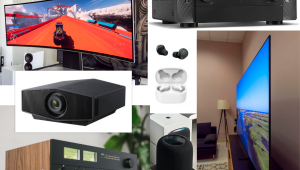CES 2001: New Products, Bold Predictions
Speaking to a packed house, Philips Consumer Electronics Mainstream CEO Guy Demuynck said his company's emphasis in 2001 will be to "focus on core competencies," pushing the boundaries for optical storage and video display technologies. With over one million 16:9 television sets in European consumers' homes and a strong market presence in related product categories, Philips is well positioned to take display technology to the next level. Displays of all sizes and types—LCD, LCD-projection, CRT, CRT-flat screen, CRT-projection, and gas plasma units—are currently made and marketed by Philips. All are also part of a constant program of refinement.
Among the most impressive products on display at CES is Philips' 34-inch diagonal flat screen TV, model 34W9846, winner of an "Innovation Award" by the Industrial Designers Society of America (IDSA). "The 'Real Flat' tube is like looking through a window," said Demuynck, "By 2002 we will offer a full line of Real Flat products in all sizes." Demuynck also predicts substantial growth in the LCD market, and expects his company to sell as many as 32 million units worldwide by 2004.
He is extremely excited about Philips' new DVD recorder, the DVDR-1000, which will be introduced into the US market this coming summer. "The perfect device for storage and editing of digital home movies," Demuynck called it, skirting copyright issues involved in consumers' use of such machines to record commercial films and television shows. "As easy to use as a VCR," the DVDR-1000 will record on DVD+RW discs, and will play DVD-video, VCD, S-VCD, CD, CD-R, and CD-RW discs. No compatibility with DVD-audio was mentioned by Demuynck or appears in any company-supplied press releases.
Philips, a partner with TiVo in the hard-disk video recorder sector, plans to push that market as well with new, more versatile, and more affordable products—although the format is hampered by its inability to transfer recordings to a permanent archive. Clearly, Philips sees the video future as much stronger for DVD recordables, as CD recordables have proven for the audio market. Despite heat and pressure from the music industry, copyright issues haven't hindered the market for CD-R, and ultimately may not for the DVD+RW market, an eventuality Philips is betting on strongly.
Sony's pre-show press conference followed on the heels of Philips' with the announcement of the KV-40XBR700 FD Trinitron Wega Television featuring a 4:3 40-inch CR display. Sony claims that the TV incorporates several enhancements to the company's proprietary XBR features, including the next-generation Digital Reality Creation (DRC) MultiFunction with CineMotion reverse 3:2 pulldown process. Sony explains that this process minimizes artifacts caused when 24-frame-per-second film is transferred to 30-frame-per-second video. The Wega television will be available in October for about $4,000.
Also on display is Sony's Grand Wega Television, a 50-inch, 16 x 9 demonstration model that incorporates three wide XGA LCD panels, and a proprietary optical engine that Sony claims will increase brightness and resolution. Sony says that the Grand Wega TV is intended to set new standards for rear-projection LCD technology in a "slim, sleek and lightweight frame." Introduction plans and pricing for the Grand Wega television are still being finalized.
Sony also debuted the DVP-NS700P DVD/CD player, which offers 480 progressive video output, 12 Bit/54 MHz DA conversion, and a multifunction MPEG processor. It will be available in June for about $400.
Like Philips, which is also supporting DVD+RW, Sony displayed a prototype RW Dual Compatible Recorder that will support both DVD-RW and DVD+RW media. The RW Dual Compatible Recorder is scheduled for introduction in mid-2002. Sony also introduced its DVR-Blue Technology, which the company describes as a next-generation optical disc recorder featuring a blue-violet laser diode. "With more than 22GB capacity, DVR-Blue technology can store the same amount of data as five current DVDs. It also offers a high enough data transfer rate to record up to 2 ½ hours of high-definition video, or more than 10 hours of standard-definition video," sais Sony. The company adds that DVR-Blue commercialization has not yet been finalized.
























































